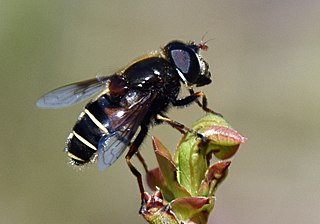
Eristalis cryptarum is a holarctic species of hoverfly. Known as the bog hoverfly or bog-dwelling drone fly, it is a bog specialist but may occur in other wetlands. Its larvae are assumed to live in peat that is saturated with water, such as that found in these boggy areas. The female has been observed depositing eggs on and close to very fresh cow dung along oligotrophic seepages in moorland.
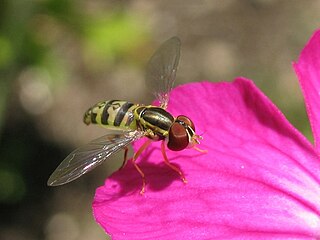
Toxomerus geminatus (Say,1823) the Eastern Calligrapher, is a common species of syrphid fly observed in the eastern and central United States and Canada.(see map) Syrphid flies are also known as Hover Flies or Flower Flies because the adults are frequently found hovering around flowers from which they feed on nectar and pollen. Adults are 6.1–7.6 mm (0.24–0.30 in) long. The larvae are predators of a variety of aphids and mites.

Eristalis flavipes, the orange-legged drone fly, is a species of hoverfly native to North America. It flies from early April to mid-October, and occurs in a wide variety of habitats, particularly wetlands. Hoverflies get their names from the ability to remain nearly motionless while in flight. The adults are also known as flower flies for they are commonly found around and on flowers, from which they get both energy-giving nectar and protein-rich pollen. The larvae are aquatic filter-feeders of the rat-tailed type.

Brachyopa flavescens, The Yellow Sapeater, is a fairly common species of syrphid fly. It has been observed in northeastern North America. Hoverflies get their names from the ability to remain nearly motionless while in flight. The adults are also known as flower flies for they are commonly found around and on flowers, from which they get both energy-giving nectar and protein-rich pollen. Larvae for this genus are of the rat-tailed type. B.flavescens larvae have not been described.
Blera nigra , the golden-haired wood fly, is a fairly common species of syrphid fly first officially described by Williston in 1887 Hoverflies get their name from the ability to remain nearly motionless while in flight The adults are also known as flower flies for they are commonly found around and on flowers from which they get both energy-giving nectar and protein rich pollen. The larvae are of the rat-tailed type feeding on exuding sap or in the rot holes of trees.
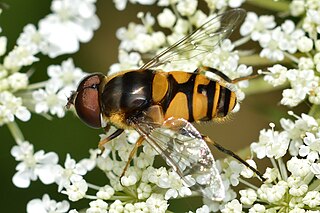
Eristalis transversa, the transverse banded drone fly, is a common species of syrphid fly first officially described by Wiedemann in 1830. Hoverflies get their names from the ability to remain nearly motionless while in flight. The adults are also known as flower flies for they are commonly found around and on flowers, from which they get both energy-giving nectar and protein-rich pollen. The larvae are rat-tailed type but larvae of this specific species has not been reported.

Helophilus lapponicus, the Yellow-margined Marsh Fly, is a common species of syrphid fly observed across northern North America, northern Europe, Greenland and Siberia. Hoverflies can remain nearly motionless in flight. The adults are also known as flower flies for they are commonly found on flowers, from which they get both energy-giving nectar and protein-rich pollen. Though common the larvae of this species are not known but the larvae of other species in this genus are associated with wet decaying organic material, particularly accumulations of decaying vegetation in ponds and mud and are a so called rat-tailed type.

Blera umbratilis, the hairy wood fly, is an uncommon species of syrphid fly first officially described by Williston in 1887. Hoverflies get their names from the ability to remain nearly motionless while in flight. The adults are also known as flower flies for they are commonly found around and on flowers, from which they get both energy-giving nectar and protein-rich pollen. The larvae are of the rat-tailed type, feeding on exuding sap or in the rot holes of trees.
Hadromyia aepalius, the Sterling Quicksilver, is a rare species of syrphid fly found in eastern North America. Hoverflies get their names from the ability to remain nearly motionless while in flight. The adults are also known as flower flies for they are commonly found around and on flowers, from which they get both energy-giving nectar and protein-rich pollen.

Blera pictipes, the painted wood fly, is a rare species of syrphid fly first officially described by Bigot in 1883. Hoverflies get their names from the ability to remain nearly motionless while in flight. The adults are also known as flower flies for they are commonly found around and on flowers, from which they get both energy-giving nectar and protein-rich pollen. The larvae are of the rat-tailed type, feeding on exuding sap or in the rot holes of trees.

Brachyopa daeckei, the black-tailed sapeater, is a rare species of syrphid fly that has been observed in northeastern North America. Hoverflies get their names from the ability to remain nearly motionless while in flight. The adults are also known as flower flies for they are commonly found around and on flowers, from which they get both energy-giving nectar and protein-rich pollen. Larvae for this genus are of the rat-tailed type. B.daeckei larvae have not been described.

Cynorhinella bella, the western longnose, is a species of hoverfly in the family Syrphidae.
Blera analis, the orange-tailed wood fly, is an uncommon species of syrphid fly. It was officially described by Macquart, 1842. Hoverflies get their names from their ability to remain nearly motionless while in flight. The adults are also known as flower flies for they are commonly found around and on flowers from which they get both energy-giving nectar and protein-rich pollen. The larvae are of the rat-tailed type feeding on exuding sap or in the rot holes of trees.

Helophilus obscurus , the obscure marsh fly, is a common species of syrphid fly observed throughout Canada and the northern United States and Rocky Mountains. Hoverflies can remain nearly motionless in flight. The adults are also known as flower flies for they are commonly found on flowers, from which they get both energy-giving nectar and protein-rich pollen. The larvae of this genus are associated with wet decaying organic material, particularly accumulations of decaying vegetation in ponds and mud and farmyard manure or silage the larvae of this species are not known.
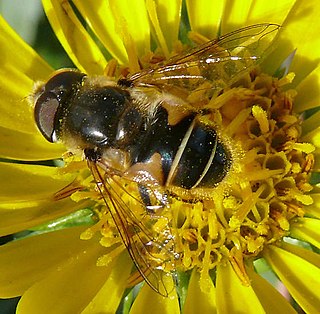
Eristalis hirta, the black-footed drone fly, is a common Western North American species of syrphid fly, first officially described by Loew in 1866. Hoverflies get their names from the ability to remain nearly motionless while in flight. The adults are also known as flower flies as they are commonly found on and around flowers, from which they get both energy-giving nectar and protein-rich pollen. The larvae are aquatic filter-feeders of the rat-tailed type.

Brachyopa caesariata, the Plain-winged Sapeater, is an uncommon species of syrphid fly. It has been observed in Canada, Alaska and northern United States. Hoverflies get their names from the ability to remain nearly motionless while in flight. The adults are also known as flower flies for they are commonly found around and on flowers, from which they get both energy-giving nectar and protein-rich pollen. Larvae for this genus are of the rat-tailed type. B.caesariata larvae have not been described.
Sericomyia carolinensis, is a rare species in the family Syrphidae, found in the Southeastern part of the United States. It is distinguished by its all yellow face, single pair of small narrow yellow spots, and yellow pilose scutellum. Adults noted feeding on pear blossoms. The larval stage is unknown but is likely a "rat tailed" type larvae inhabiting nutrient rich waters, typical for the genus Sericomyia.

Eristalis brousii, also known as the hourglass drone fly, is a fly species in the Syrphidae family first described by Samuel Wendell Williston in 1882. The species has become largely extinct outside of Northern Canada. Eristalis brousii are part of the hoverfly family, known for hovering above flowers to collect nectar and pollen.
Microdon ruficrus, the spiny-shield ant fly, is an uncommon species of syrphid fly observed in the eastern United States and adjacent Canada. Hoverflies can remain nearly motionless in flight. The adults are also known as flower flies for they are commonly found on flowers from which they get both energy-giving nectar and protein-rich pollen. Larvae have been found from the nests of Lasius americanus formerly Lasius alienus. GBIF external link to images
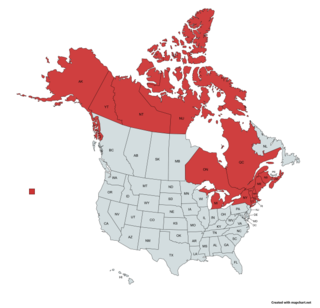
Dasysyrphus laticaudus, the boreal conifer fly, is a common species of syrphid fly observed in Eastern and Northern North America. Hoverflies can remain nearly motionless in flight. The adults are also known as flower flies for they are commonly found on flowers, from which they get both energy-giving nectar and protein-rich pollen. The larvae of this genus are aphid predators. .

















